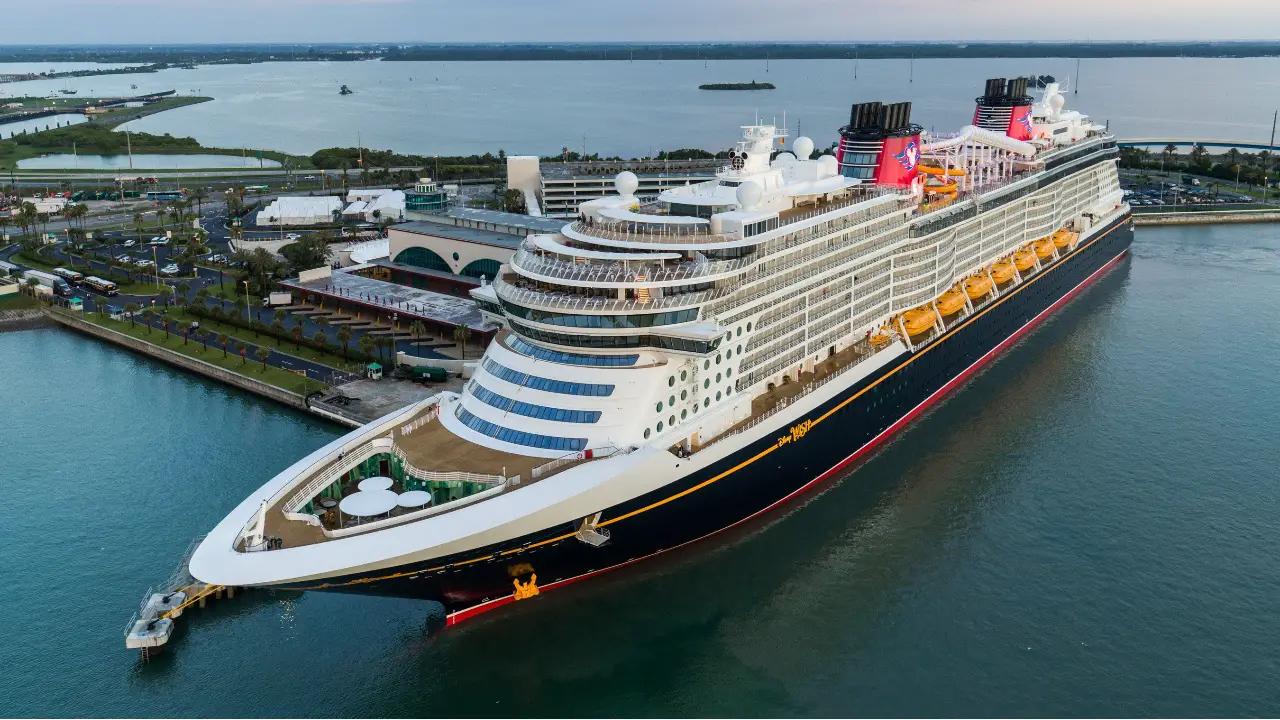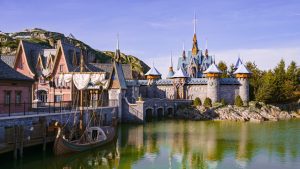The Disney Cruise Line’s newest ship, the Disney Wish, was christened this week and is currently cruising with special guests and members of the media aboard. This cruise ship is one of the most fuel efficient cruise ships on the sea. Disney shared some details about the efforts to make this ship as efficient as possible. First, it utilizes a combination of liquefied natural gas (LNG) and numerous advances in ship design to be 30% more efficient and emit 20% fewer greenhouse gases.
“At Disney Cruise Line, we remain dedicated to limiting our impact on the environment as we support The Walt Disney Company’s commitment to net-zero emissions by 2030,” said Sharon Siskie, Senior Vice President and General Manager of Disney Cruise Line. “We continue to look for innovative ways to make a difference across our entire fleet, including using new technology to increase fuel efficiency and reduce energy consumption.”
Because of the use of LNG, the Disney Wish eliminates nearly all harmful sulfur oxides (SOx) and particulate matter emissions, reduces the emission of a greenhouse gas known as nitrogen oxide (NOx) by 37%, and reduces onboard carbon dioxide (CO2) emissions by approximately 20 percent. This continues a trend of using cleaner-burning fuels to power Disney Cruise Line ships. In 2020, Disney Cruise LIne converted its current four-ship fleet to ultra-low sulfur fuel. This exceeds international maritime regulations and is better for the environment.
The Disney Wish saves energy in other ways. It utilizes next-generation heating and cooling systems, LED lighting, an advanced wastewater purification system, hydrodynamic hull, and propulsion designs, and also other systems that are designed and optimized for energy conservation.
The engine room of the Disney Wish has a system that repurposes heat from the engines to warm the super-cooled LNG that powers the ship. On the flip side, the cold energy from the LNG tanks is recycled into the ship’s air-conditioning systems. This reduces the electricity that is needed to keep the interior of the ship cool and also saves the Disney Wish 200 tons of fuel annually.
The ship also has a demand-based heating and cooling system. This will also save energy by adapting to real-time conditions to give the ideal amount of hot or cold air to Guests’ staterooms, galleys, and other areas aboard the ship. This will conserve 700 tons of fuel annually and also make the ship more comfortable for its passengers and crew. The ship also uses LED bulbs in 90% of the ship’s lighting. This also reduces energy consumption by 30 percent and also will lessen the demand on the ship’s cooling systems since they are cooler lights.
The Disney Wish also recycle naturally occurring condensation from the onboard air-conditioning units and save approximately 7.5 million gallons of fresh water each year. This can then be used for onboard laundry facilities or to clean the outer decks of the ship. Reverse osmosis is also used to turn ocean water into potable water. There is also an energy efficient wastewater treatment system onboard that saves about 500 tons of fuel each year while purifying the ship’s wastewater to levels that far exceed international shipping standards.
The ship design is also advanced and allows the Disney Wish to glide through the water with little resistance. This is done with a hydrodynamic hull and propeller, both are shaped to limit the ship’s resistance in the water and thereby reducing the engine power needed to move the ship forward. This also saves nearly 1,800 tons of fuel annual while reducing greenhouse gas emissions by 6%. The sides of the hull are also coated with a slick, silicone-based paint that also helped reduce friction against the water. This also will limit the growth of barnacles to help further limit drag.
The ship continues Disney Cruise Line’s initiatives to reduce waste and also conserve resources through multiple initiatives. There are washable dinnerware offered at all food and beverage locations for Guests to use rather than single-use plastic utensils. Biodegradable straws are also utilized over plastic ones. There are also refillable water stations found throughout the ship for both Guests and crew members to refill water bottles. There are also extensive recycling efforts onboard and other programs like the partnership with Nassau offload used cooking oil for recycling into biodiesel fuel.
Environmental Officers are also on board the Disney Wish, as they are on all of the Disney Cruise Line ships. They are ranked as some of the most senior officers aboard. For the Disney Wish, Catalina Jaques and Karl Brown are serving as Disney Wish’s inaugural Environmental Officers. They are charged with monitoring the ship’s water quality and supply, training both officers and crewmembers, and also overseeing multiple environmental initiatives. There is a state-of-the-art energy monitoring and management system that tracks the hip’s performance. These officers work with the crew of the Disney Wish and also Disney Cruise Line Cast Members on land to make sure that the ship is operating at maximum efficiency and also looking for places for improvement.
“It is an honor and privilege to serve as an inaugural Environmental Officer for this magnificent ship,” said Jaques, who comes to the Disney Wish with 10 years of experience in the maritime industry. “The ship is infused with more Disney storytelling than ever before, and DCL’s many environmental investments are part of that story. I am excited to continue working with my fellow cast and crew members to ensure the Wish remains one of the most energy efficient cruise ships on the water, now and well into the future.”
Disney Wish will continue to be moving forward with new technologies. Next year it is expected to be equipped with a 1-megawatt fuel cell. This will be one of the largest installations of its kind in a marine environment and will act as a battery to provide additional emission-free energy for systems aboard the ship. A fuel cell like this has enough power to run all of the ship’s galleys and elevators. This will be a prototype installation and help both the Disney Cruise Line, but also the industry, to understand the feasibility of the technology aboard cruise and shipping vessels.
“All of our Disney Cruise Line ships were built with some of the most advanced systems available at the time, and we continue to invest in our fleet by incorporating the latest technology that helps us minimize our impact on the environment,” said Siskie. “The Disney Wish serves as a floating lab that will help us discover how new innovations can be used throughout the rest of our fleet to help us meet our environmental goals.”
What do you think of the efforts being made aboard the Disney Wish to make this ship as energy efficient and environmentally friendly as possible? Share your thoughts and opinions in the comments below!






